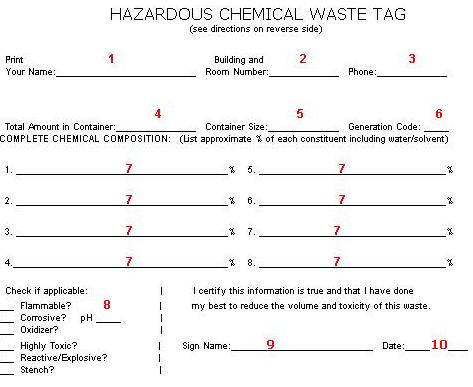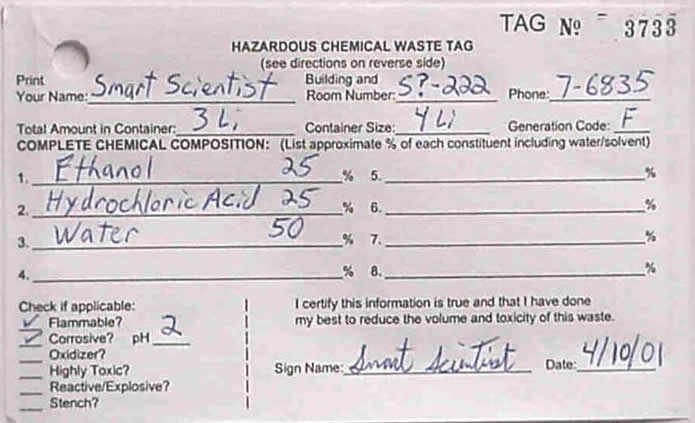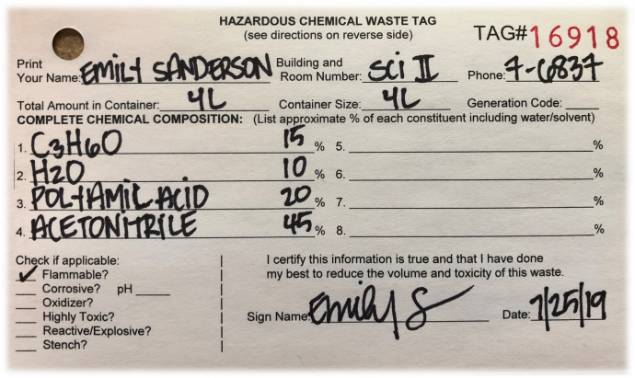The Hazardous Chemical Waste Tag serves many important functions in the proper disposal of chemicals. The obvious function is identifying what exactly is in the container. Often bottles are used for waste collection and the original label on the container does not accurately describe its contents. Be sure to deface any container label that does not accurately describe its contents. The Hazardous Chemical Waste Tag is also used to create an inventory log of hazardous waste generated on campus.
In general every container needs its own tag, unless you have numerous small containers (i.e., vials) with exactly the same contents in the same quantity. In this case, note on the tag how many containers you have and place the containers in a box.
The tag must be filled out completely and attached to the container. Please be sure to read the directions on the back and completely fill out the front of each tag. Hazardous Chemical Waste Tags can be obtained at Science Stores or from Environmental Health & Safety.
How to Fill Out A Hazardous Chemical Waste Tag

- PRINT YOUR NAME: This should be the person generating the waste or someone who has knowledge about the waste in case additional information is needed.
- BUILDING AND ROOM NUMBER: Where the waste was generated. Please remember to include BOTH the BUILDING and ROOM NUMBER
- PHONE #: This is important in case additional information is needed.
- TOTAL AMOUNT IN CONTAINER: Approximate amount of waste present in the container.
- CONTAINER SIZE: The size of the container holding the waste.
- GENERATION CODE: The type of program under which the waste was generated.
F=Funded Research I=Instructional M=Maintenance O=Other - COMPLETE CHEMICAL COMPOSITION: It is important that ALL chemical names be written out and the approximate percentages of EACH constituent be listed. Chemicals in amounts of <1% can be written as “trace”. Also include the percentage of water or solvent present. Final reaction products should be listed instead of chemical equations. Chemical structures, formulas, abbreviations, or acronyms are NOT acceptable. Chemical names MUST be written out.
- APPLICABLE HAZARDS: While this can be helpful, if you are unsure or do not know, then leave this section blank. In the case of mixed waste, make sure that all reactions are complete before checking the pH as this can change over a short period of time.
- CERTIFICATION: The hazardous waste regulations require that generators of hazardous waste certify that they are practicing waste minimization. In addition, by signing the certification you are assuming the responsibility that the waste generated is accurately described in the chemical composition section. The generator of the waste must sign when the container is full.
- DATE: Leave the date blank! We will fill in the date when we pick up your waste.
Please keep in mind that the hazardous waste management program collects waste throughout the ENTIRE Binghamton campus. Your cooperation in completely and legibly filling out Hazardous Chemical Waste Tags is greatly appreciated.
Sample Tag
Here are a few sample tags. If you have any questions about tag procedures, please feel free to contact us at hazwaste@binghamton.edu, or call EH&S at 777-2211

Figure 1: Sample tag used in our Right-to-Know training for years! This one should look familiar.

Figure 2: EPA and DOT regulations prohibit the use of chemical formulas. These chemicals MUST be spelled out.
--SHOULD BE--
- Acetone 15%
- Water 10%
- Should NOT be dated!
- Amount in container exceeds 90%
Questions and Guidance
Any questions about the Hazardous Waste Management Program, or how to dispose of Hazardous Waste can be directed to the Department of Environmental Health and Safety at x 7-2211 or by email at hazwaste@binghamton.edu.